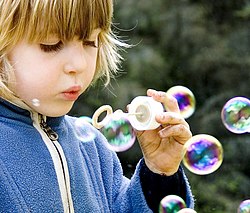Bermain



Bermain adalah aktivitas dan kualitas pikiran dalam terlibat dengan pandangan dunia seseorang. Bermain mengacu pada berbagai aktivitas sukarela yang termotivasi secara intrinsik yang biasanya diasosiasikan dengan kesenangan dan keseruan.[1]
Banyak peneliti terkemuka di bidang psikologi, termasuk Melanie Klein, Jean Piaget, William James, Sigmund Freud, Carl Jung, dan Lev Vygotsky, secara keliru menganggap bermain terbatas pada spesies manusia, percaya bahwa bermain itu penting bagi manusia. perkembangan manusia dan menggunakan metode penelitian yang berbeda untuk menguji teori mereka.
Bermain dapat terdiri dari interaksi lucu, pura-pura atau imajiner antara individu dan dengan diri mereka sendiri atau mainan. Praktek bermain terbukti di seluruh dunia dan dapat dilihat pada manusia dan hewan, khususnya dalam perkembangan kognitif dan sosialisasi mereka yang terlibat dalam proses perkembangan dan anak muda. Bermain sering menggunakan alat peraga, alat, binatang, atau mainan dalam konteks pembelajaran dan rekreasi. Beberapa permainan memiliki tujuan yang jelas dan jika disusun dengan aturan disebut permainan. Sementara beberapa permainan tidak memiliki aturan atau tujuan seperti itu dan dianggap "tidak terstruktur" dalam literatur.
Referensi
- ^ Garvey, C. (1990). Play. Cambridge, MA: Harvard University Press.
Bacaan lebih lanjut
- Caillois, R. (2001). Man, play, and games. Urbana and Chicago, University of Illinois Press (originally published in 1958; translated from the French by Meyer Barash).
- Encyclopedia: Play Science Scholarpedia
- Huizinga, J. (1955). Homo ludens; a study of the play-element in culture. Boston: Beacon Press.
- Jenkinson, Sally (2001). The Genius of Play. Hawthorn Press
- Sutton-Smith, B. (1997). The ambiguity of play. Cambridge: Harvard University Press.
- Burghardt, Gordon M. The Genesis of Animal Play: Testing the Limits [1]
- Wenner, M. (2009). "The Serious Need for Play" – Free, imaginative play is crucial for normal social, emotional and cognitive development. It makes us better adjusted, smarter and less stressed, Scientific American.
- Gray, P. (2009). "Play as a Foundation for Hunter-Gatherer Social Existence" (PDF). American Journal of Play. 1 (4): 476–522. ISSN 1938-0399. ERIC #EJ1069037.
- Gray, P. (2013). Free to Learn: Why Unleashing the Instinct to Play Will Make Our Children Happier, More Self-Reliant, and Better Students for Life
- Gray, P. (2008–2009). "Social Play and the Genesis of Democracy", "The Value of Play I: The Definition of Play Provides Clues to Its Purposes", "The Value of Play II: How Play Promotes Reasoning in Children and Adults", "The Value of Play III: Children Use Play to Confront, not Avoid, Life's Challenges and Even Life's Horrors", "The Value of Play IV: Play is Nature's Way of Teaching Us New Skills", "How to Ruin Children's Play: Supervise, Praise, Intervene", Psychology Today.
- Howard Taras, (2009). Journal of School Health. Physical Activity and School Performance. 75 (6), pp. 214–218
- Kortmulder, Koenraad (1998). Play and Evolution: Second Thoughts on the Behaviour of Animals, ISBN 978-90-5727-013-0
- Piaget, J. (1962). Play, dreams and imitation (Vol. 24). New York: Norton
- Bateson, Gregory. (1955). A theory of play and fantasy. Psychiatric research reports,2(39), 39–51. Reprinted in Steps to an Ecology of Mind, 1972. Chandler, and 2000, University of Chicago Press.
- Stebbins, Robert A. (2015). The Interrelationship of Leisure and Play: Play as Leisure, Leisure as Play. Houndmills, UK: Palgrave Macmillan.
- Wästerfors, David (2016). "Playfights as Trouble and Respite". Journal of Contemporary Ethnography. 45 (2): 168–197. doi:10.1177/0891241614554087.
Pranala luar
| Sumber pustaka mengenai Bermain |
![]() Media tentang play di Wikimedia Commons
Media tentang play di Wikimedia Commons
- The National Institute for Play
- The Play Foundation
- IPA World Home (International Play Association: Promoting the Child's Right to Play)
- Creative Play
- Brown, Stuart (2008) Why play is vital – no matter your age Diarsipkan 2009-03-15 di Wayback Machine., TEDtalks, TED.com
